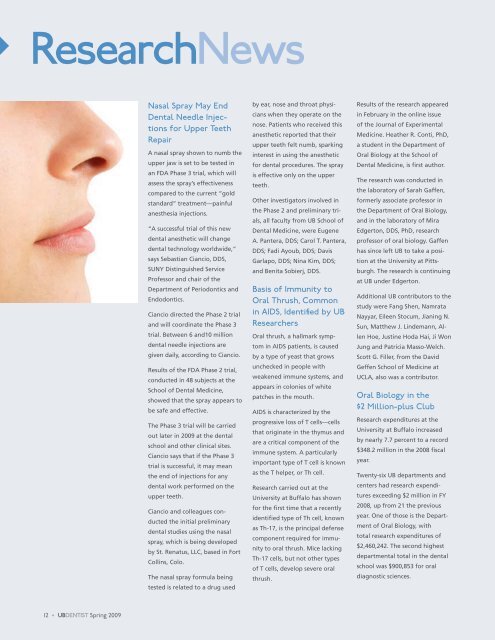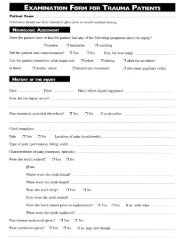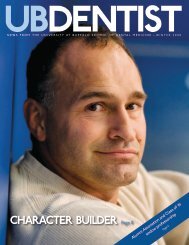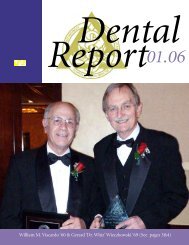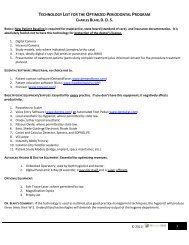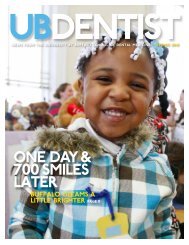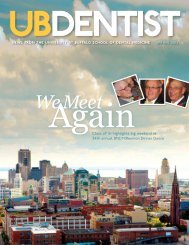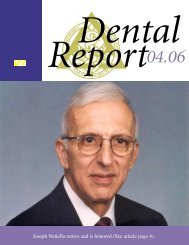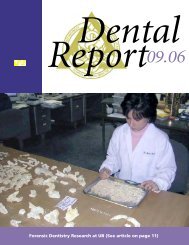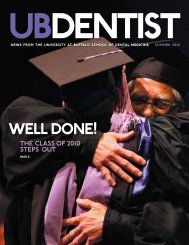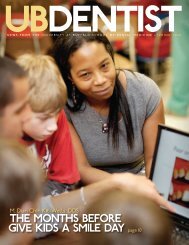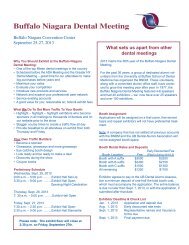You also want an ePaper? Increase the reach of your titles
YUMPU automatically turns print PDFs into web optimized ePapers that Google loves.
esearchnews<br />
12 u <strong><strong>UB</strong>Dentist</strong> spring 2009<br />
nasal spray may End<br />
dental needle injections<br />
for upper Teeth<br />
repair<br />
A nasal spray shown to numb the<br />
upper jaw is set to be tested in<br />
an FDA Phase 3 trial, which will<br />
assess the spray’s effectiveness<br />
compared to the current “gold<br />
standard” treatment—painful<br />
anesthesia injections.<br />
“A successful trial of this new<br />
dental anesthetic will change<br />
dental technology worldwide,”<br />
says Sebastian Ciancio, DDS,<br />
SUNY Distinguished Service<br />
Professor and chair of the<br />
Department of Periodontics and<br />
Endodontics.<br />
Ciancio directed the Phase 2 trial<br />
and will coordinate the Phase 3<br />
trial. Between 6 and10 million<br />
dental needle injections are<br />
given daily, according to Ciancio.<br />
Results of the FDA Phase 2 trial,<br />
conducted in 48 subjects at the<br />
School of <strong>Dental</strong> Medicine,<br />
showed that the spray appears to<br />
be safe and effective.<br />
The Phase 3 trial will be carried<br />
out later in 2009 at the dental<br />
school and other clinical sites.<br />
Ciancio says that if the Phase 3<br />
trial is successful, it may mean<br />
the end of injections for any<br />
dental work performed on the<br />
upper teeth.<br />
Ciancio and colleagues conducted<br />
the initial preliminary<br />
dental studies using the nasal<br />
spray, which is being developed<br />
by St. Renatus, LLC, based in Fort<br />
Collins, Colo.<br />
The nasal spray formula being<br />
tested is related to a drug used<br />
by ear, nose and throat physicians<br />
when they operate on the<br />
nose. Patients who received this<br />
anesthetic reported that their<br />
upper teeth felt numb, sparking<br />
interest in using the anesthetic<br />
for dental procedures. The spray<br />
is effective only on the upper<br />
teeth.<br />
Other investigators involved in<br />
the Phase 2 and preliminary trials,<br />
all faculty from <strong>UB</strong> School of<br />
<strong>Dental</strong> Medicine, were Eugene<br />
A. Pantera, DDS; Carol T. Pantera,<br />
DDS; Fadi Ayoub, DDS; Davis<br />
Garlapo, DDS; Nina Kim, DDS;<br />
and Benita Sobierj, DDS.<br />
basis of immunity to<br />
oral Thrush, common<br />
in aids, identified by ub<br />
researchers<br />
Oral thrush, a hallmark symptom<br />
in AIDS patients, is caused<br />
by a type of yeast that grows<br />
unchecked in people with<br />
weakened immune systems, and<br />
appears in colonies of white<br />
patches in the mouth.<br />
AIDS is characterized by the<br />
progressive loss of T cells—cells<br />
that originate in the thymus and<br />
are a critical component of the<br />
immune system. A particularly<br />
important type of T cell is known<br />
as the T helper, or Th cell.<br />
Research carried out at the<br />
University at Buffalo has shown<br />
for the first time that a recently<br />
identified type of Th cell, known<br />
as Th-17, is the principal defense<br />
component required for immunity<br />
to oral thrush. Mice lacking<br />
Th-17 cells, but not other types<br />
of T cells, develop severe oral<br />
thrush.<br />
Results of the research appeared<br />
in February in the online issue<br />
of the Journal of Experimental<br />
Medicine. Heather R. Conti, PhD,<br />
a student in the Department of<br />
Oral Biology at the School of<br />
<strong>Dental</strong> Medicine, is first author.<br />
The research was conducted in<br />
the laboratory of Sarah Gaffen,<br />
formerly associate professor in<br />
the Department of Oral Biology,<br />
and in the laboratory of Mira<br />
Edgerton, DDS, PhD, research<br />
professor of oral biology. Gaffen<br />
has since left <strong>UB</strong> to take a position<br />
at the University at Pittsburgh.<br />
The research is continuing<br />
at <strong>UB</strong> under Edgerton.<br />
Additional <strong>UB</strong> contributors to the<br />
study were Fang Shen, Namrata<br />
Nayyar, Eileen Stocum, Jianing N.<br />
Sun, Matthew J. Lindemann, Allen<br />
Hoe, Justine Hoda Hai, Ji Won<br />
Jung and Patricia Masso-Welch.<br />
Scott G. Filler, from the David<br />
Geffen School of Medicine at<br />
UCLA, also was a contributor.<br />
oral biology in the<br />
$2 million-plus club<br />
Research expenditures at the<br />
University at Buffalo increased<br />
by nearly 7.7 percent to a record<br />
$348.2 million in the 2008 fiscal<br />
year.<br />
Twenty-six <strong>UB</strong> departments and<br />
centers had research expenditures<br />
exceeding $2 million in FY<br />
2008, up from 21 the previous<br />
year. One of those is the Department<br />
of Oral Biology, with<br />
total research expenditures of<br />
$2,460,242. The second highest<br />
departmental total in the dental<br />
school was $900,853 for oral<br />
diagnostic sciences.


